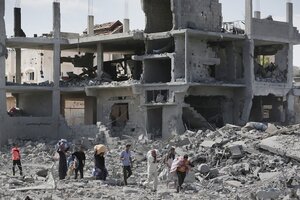Amid cease-fire, Gaza residents head home to find widespread destruction
In the city of Beit Hanoun, near the border with Israel, house after house was flattened, reduced to piles of rubble, or an empty shell. For one resident, it was a call to resistance.

Thousands of Gaza residents who had fled Israel-Hamas fighting in areas along the Israel-Gaza border streamed back during a cease-fire Saturday to find large-scale destruction. In Beit Hanoun, some tried to salvage belongings from the rubble.
Lefteris Pitarakis/AP
Beit Hanoun, Gaza Strip
Palestinians in Gaza rushed to check on their homes and families today as a temporary humanitarian pause in the fighting allowed them access to areas that had been the scene of intense attacks until this morning.
In many cases, what they found when they arrived were scenes of terrible devastation.
In the northeastern city of Beit Hanoun, near the border with Israel, house after house was flattened, reduced to piles of rubble, or an empty shell, with many others suffering extensive damage. Dead horses and donkeys littered the streets, and in places the stench of death emanated from the rubble. One neighborhood near the border was rendered nearly unrecognizable for the residents who returned hoping to find anything salvageable amid the debris. Some people tried to dig out the bodies of their families still trapped under the rubble.
“Total destruction,” said one man as he stumbled through the chunks of concrete and steel. “This is a town of ghosts, not a town of people.”
The scale of damage in areas where the Israeli military pushed in with ground forces after heavy shelling and airstrikes, revealed in full for the first time during the truce today, makes it clear that Gaza's crisis of displaced people will not end with this conflict. More than 150,000 people in a population of 1.8 million have already sought refuge in UN shelters, while many more have taken shelter with relatives. The destruction also highlights the enormous challenge this impoverished territory – which has been under a strict blockade on construction materials since 2007 – will face in rebuilding.
Not one intact building
In Beit Hanoun, most residents fled their homes a week ago as Israel heavily shelled the area and pressed into the town with ground troops. Tank tracks marred the streets, and the military appeared to have retreated from areas it in which it was operating until today. Damage was pervasive throughout the city, but in the Al Masriyeen neighborhood, it was massive. The entire street was painted in a gray dust, the pink clothing fluttering from the window of a destroyed home offering nearly the only contrast.
Squatting on the rubble of his entirely destroyed home, Hamza al-Masri surveyed the damage. Not a building on that area of the street remained intact. Cars were unable to navigate the street. A steady stream of people filed past him, picking their way through the rubble as they carried mattresses, blankets, and whatever they could find in their homes.
Mr. Masri had arrived in the morning, not knowing what to expect, only to find a crater and crumbled cement where he had once lived, in a neighborhood where he said many fought against Israel.
He and his extended family, around 50 people, left this building on Monday, after neighboring buildings were bombed. They took refuge in a UN school-turned shelter in Beit Hanoun, hoping to find safety there. But that shelter was hit by apparent Israeli artillery fire Thursday, killing 16 people. His family has since moved to another UN school in Jabaliya refugee camp. “Where is safe? There is no safety,” he said. “Where are we going to go?”
When his family fled, they took nothing, and he returned today hoping to gather clothes. But the building was pulverized, with nothing to salvage among the chunks of concrete. “We don't want a cease-fire after the destruction we've seen,” he said. “We want resistance, that's it.”
Next to his destroyed home, the body of his neighbor was still buried under the rubble of his house.
Nearby, Mustafa al-Masri carried a yellow birdcage as he struggled to create a path between chunks of concrete, steel rebar, and downed electricity lines. He had just returned from making one last trip to his home to save his canary, named Zooba. Inside his home, one of few in the area left intact, he found signs that Israeli troops had used it as a base. Packaging from American military rations lay on the ground, with a bottle of bug spray with writing in Hebrew, and an intravenous line apparently used by a wounded soldier. There was evidence that the soldiers had used the house during clashes with militants. Spent bullet casings littered the floor under a window in his parents' bedroom, which had been ransacked. And on the roof were more spent bullet casings under an opening in the wall, as well as the launchers of two used light anti-tank weapons.
Detained by the military
In another neighborhood, Rami Hatem Wahdan was frantic. Israeli forces raided his house and detained Mr. Wahdan and most of the male members of his family when they pushed into Beit Lahiya a week ago. They blindfolded Wahdan, his father, uncle, and three brothers, and took them away, leaving his grandparents, his mother, his two sisters, his 2-year-old niece, and young teenage brothers behind in the house.
The Israeli military held Wahdan for two days, he says, interrogating him for information about militants. When they released him, it was too unsafe to reach his home in Beit Hanoun. He reached his relatives by phone once, but after that, nothing. When he raced to the house this morning, he found it flattened, and the smell of death hung in the air.
He wept when a relative greeted him, and desperately asked for help. “Where is the Red Cross?” he asked. “Where is the Red Crescent?”

